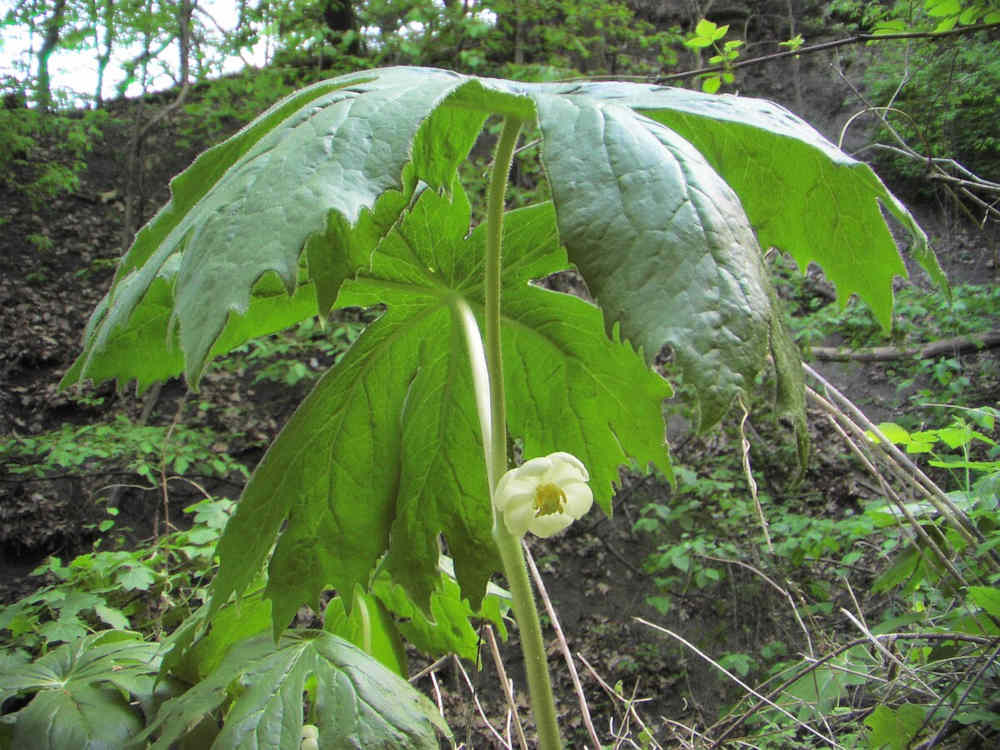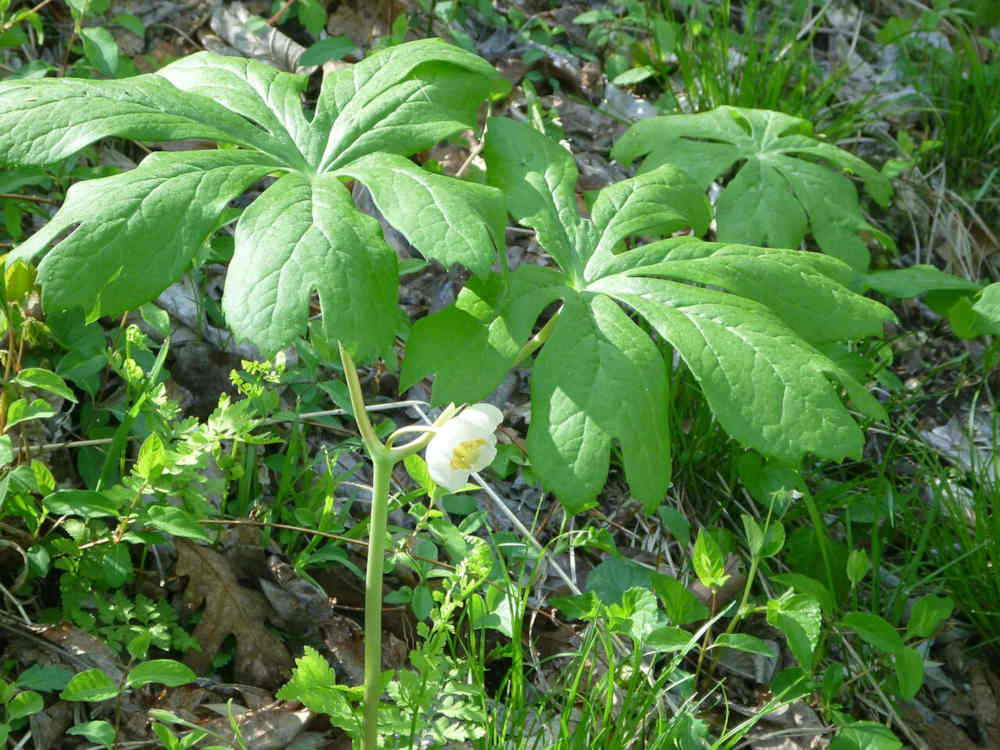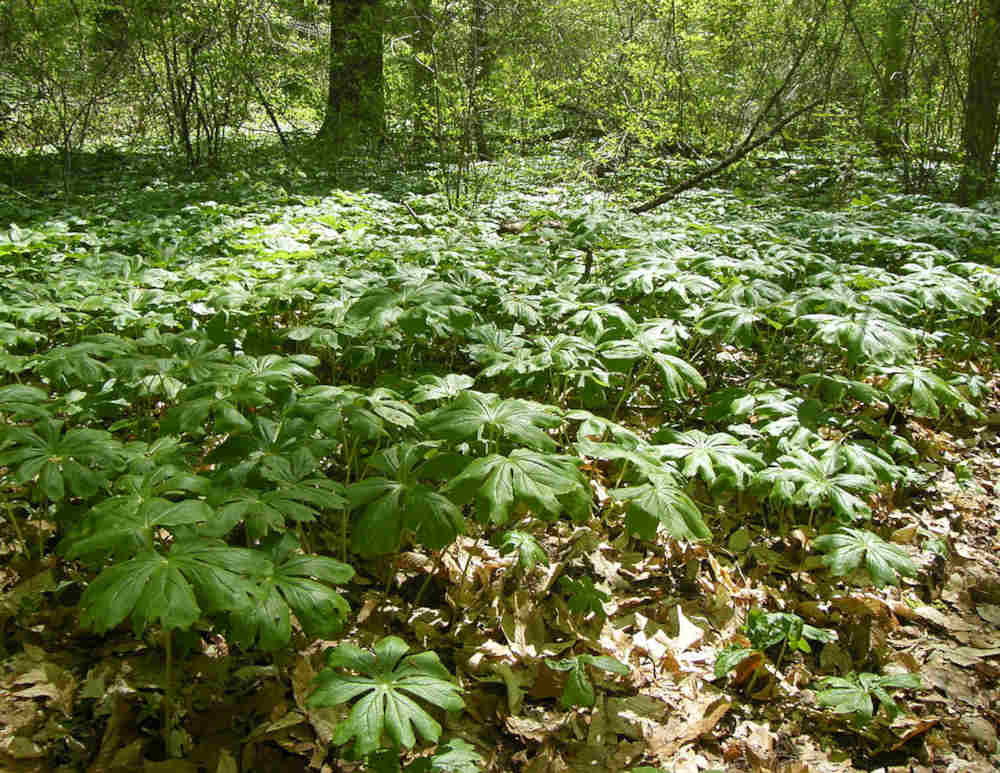The Mayapple Guide
Quick Facts

Closeup of a Mayapple with flower
Name: Mayapple or American Mandrake (Podophyllum peltatum)
Type: Spring Ephemeral
Size: Typically grows 12-18" 30-45 cm) tall and 12" (30 cm) wide)
Native Range: Eastern and Midwest North America
Growing Conditions
Low Maintenance
Sunlight: Full Shade - Grows in shaded woodlands
Soil:Likes organic rich woodland soils
Water Needs: Moist; drought-tolerant once dormant in the summer
Habit: Forms colonies and are common as woodland spring ephemerals
Wildlife and Ecological Importance:
Attracts: Spring Pollinators such as native bees and flies
Fruit: The ripe fruit is a favorite food of the Eastern Box Turtle, which plays a crucial role in the plant’s seed dispersal
Shelter:
Mayapple colonies form cool, shaded microhabitats that provide ideal shelter for small woodland animals, including salamanders and turtles
Additional Notes:
Seasonal Interest:
Umbrella-like foliage in spring - White flowers in mid to late spring - Yellow fruit in early summer - Foliage fades by midsummer
Resistance:
Deer-resistant due to toxic compounds in leaves and unripe fruit
Propagation: Spreads by underground rhizomes forming colonies. It also seeds (often dispersed by animals)
Cultural Uses: Historically used in herbal medicine by Indigenous peoples (Note: plant parts are toxic and not safe for consumption without expertise)
Replace the following Non-native with Mayapples:
Lily of the Valley
Fun Fact:
Only the fertile Mayapple stalks (with two umbrella-like leaves) produce a single flower—and eventually fruit!
Meet the Mayapple: A Woodland Springtime Classic

View of a flowering Mayapple
Introduction
Mayapples are a classic sight in Eastern deciduous forests during the spring. Known for their distinctive umbrella-shaped leaves and their quirky growth pattern, Mayapples (Podophyllum peltatum) are not only botanically intriguing but ecologically important. These spring ephemerals emerge early in the season, flourish briefly beneath leafless tree canopies, and then die back by mid-summer as the forest canopy fills in.
Native Range and Growth Habit
Mayapples are native to a wide swath of Eastern North America, ranging from Quebec and Ontario down through the Midwest and Appalachian regions, and into parts of the South. They thrive in moist, shady forests, often forming extensive colonies through underground rhizomes. These colonies typically consist of genetically identical plants, all connected by a shared root system, which allows them to spread efficiently across the forest floor.
Mayapples emerge in early spring. Each stem grows either one or two large, umbrella-like leaves. Only the two-leaved stems will bear a flower, which appears at the fork of the leaves and develops into a single yellowish-green fruit by early summer.
As a spring ephemeral, Mayapple completes most of its growth cycle in the brief window before the tree canopy fully leafs out. After fruiting, the plant dies back and remains dormant underground until the next spring.
Wildlife and Ecological Importance
While the foliage and unripe fruits of Mayapple are toxic to humans and most animals, the ripe fruit is edible for some wildlife. Turtles, especially box turtles, are known to relish the ripe fruit and play an important role in seed dispersal.
By spreading through rhizomes, Mayapples help stabilize soil and create microhabitats for insects, amphibians, and forest floor species. The thick colonies they form provide cool, shaded shelter ideal for understory animals like woodland salamanders and eastern box turtles, while also helping suppress invasive ground covers in natural areas.
Cultural and Historical Notes
Native American communities traditionally used Mayapple root in medicine, though it must be noted the plant is toxic and should never be consumed without proper knowledge and preparation. The plant’s toxicity comes from podophyllotoxin, a compound still used today in modern pharmaceuticals (such as for treating certain skin conditions and cancers).
In traditional Appalachian folk medicine, Mayapple was also used—cautiously—as a purgative, laxative, or topical treatment, reflecting the use of native plants in regional herbal practices.
A Keystone Spring Plant
Adding Mayapples to your woodland restoration not only enhances biodiversity but brings a piece of ancient forest ecology into your backyard. They arrive like clockwork each spring, offering an early burst of foliage and supporting wildlife like turtles, insects, and small mammals. If you have a densely shaded area, forest edge, or established woodland, consider planting Mayapples as a low-maintenance native groundcover that naturalizes beautifully over time. They are a symbol of seasonal change—and a reminder of how interconnected even the smallest ground plant is with the larger forest web.

A colony of Mayapples creating groundcover in the forest understory.







